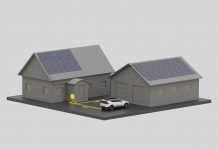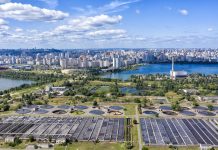Eight low carbon heat networks in London, Bristol, the West Midlands, Lincolnshire, and the North West are set to receive major investment to kick-start commercialisation and heat network construction.
Government funding through the GHNF (Green Heat Network Fund) is having a transformative impact on the heat network sector, helping to build a thriving, self-sustaining market fit for the future. This announcement highlights the broader benefits of the scheme – from advancing research & development to supporting hundreds of jobs and contributing to sustainable communities.
This announcement comes shortly after it was announced that Triple Point Heat Network Investment Management has been contracted to deliver the Government’s GHNF scheme until 2030, cementing our partnership with Government, which will now stretch to 12 years.
The following organisations have been awarded GHNF funding:
- Vattenfall receives £21.3 million of support for the Bristol City Centre heat network, combining the Frome Gateway, Canons Marsh, and St Nicks’ heat networks.
- 1Energy receives £23.2 million for the Derby Energy Network, using waste water heat recovery technology.
- Hemiko receives £15.5m for a heat network in Lincoln utilising waste heat from a data centre.
- SWAN Partnership awarded £21m for the development of the South Westminster Area Network which will recover heat from the River Thames.
- Sandwell Metropolitan Borough Council has been awarded almost £5 million to build a town-wide heat network serving buildings across West Bromwich.
- Trafford Council has been awarded £5.7 million to build a heat network using heat pumps to recover waste heat for a range of buildings across Trafford.
- Severn Wye Energy Agency awarded £1.7 million for a waste heat recovery heat network sourced from a biochar production facility, that will serve buildings in a Warrington based business park.
- East London Energy receives almost £9 million for a dual heat pump system network, recovering waste heat from both a local river and existing chillers to heat a number of developments in the Olympic Park area.
 Minister for Energy Consumers, Miatta Fahnbulleh, said, “Heat networks will play an important role in our mission for clean power by 2030, helping us to achieve energy independence and lower bills.
Minister for Energy Consumers, Miatta Fahnbulleh, said, “Heat networks will play an important role in our mission for clean power by 2030, helping us to achieve energy independence and lower bills.
“That is why this government is backing inventive projects, such as using heat generated by sewers or the River Thames to provide heating to connected businesses and homes, through the Green Heat Network Fund.”
Ken Hunnisett, Programme Director, said, “£100 million in funding is a huge milestone: a great reflection on the GHNF, the teams that will be developing and delivering them, and on the stakeholders that they’ll serve. From hospitals and homes to entire town and city centres, we’re proud to be accelerating the shift to cleaner, greener heating for communities across the country.”
Below is a summary of the projects to have been awarded funding
Vattenfall – Bristol City Centre heat network
Vattenfall is being awarded over £21 million worth of GHNF funding to support with the commercialisation and construction of the Bristol City Centre heat network (known as the Frome heat network area). This will be the largest new network area in Bristol, stretching from Cabot Circus to Millenium Square, passing some of the city’s most recognisable landmarks.
With construction beginning later this year, it will initially support new buildings being developed as part of Frome Gateway Regeneration and Bristol City Centre Development and Delivery Plan.
To generate low carbon heat, Vattenfall will build new energy centres including air source heat pumps. Ultimately, this network area will form part of one singular Bristol heat network which will meet heat demand using a combination of low carbon heat sources including water source heat pump technology and electric boilers, as well as thermal storage for resilience and efficiency during periods of high demand.
By investing in low carbon energy infrastructure, Vattenfall will significantly reduce the city’s reliance on fossil fuels to heat buildings, continuing the citywide effort to reach Bristol City Council’s decarbonisation targets through the Bristol City Leap partnership.
1Energy – Derby Energy Network
1Energy is receiving £23.2 million worth of support in today’s announcement for a heat network in Derby using 12MW of water source heat pumps to harness waste heat from organisations in the Spondon area of the city. Alongside thermal stores and a gas boiler backup, the heat network aims to connect up to 47 buildings in and around Derby, which may include buildings owned by the University of Derby, Derby College, the local council, and the University Hospitals Derby and Burton NHS Foundation Trust once complete. Other private and public sector buildings are also due to receive low carbon heat from the project.
The construction of the project will create over 100 jobs both locally and nationally.
Hemiko – Lincoln Heat Network
Hemiko has received £15.5 million of GHNF funding to support with commercialisation and construction of the Lincoln Heat Network. This ambitious heat network will initially supply low carbon heating and hot water to buildings in the city from a new data centre, which is being purpose built to meet the data needs of Lincoln’s businesses, whilst supplying cheap low carbon heat to the heat network. As the network grows over time, more heat sources will be brought on.
The GHNF funding will unlock £62m of private investment from Hemiko for phase 1 of the network, rising to £420m by 2050. With construction set to begin in Spring 2026, Hemiko will aim to create 40 local jobs over the first five years of the network, ensuring that local people benefit from the delivery of new green infrastructure in their community. Hemiko is also developing a Social Value Plan for Lincoln, in collaboration with local stakeholders, which will include providing local jobs, curriculum support, volunteering, and grants for community initiatives.
SWAN Partnership – South Westminster Area Network (SWAN)
The SWAN Partnership has secured £21 million in grant funding for the South Westminster Area Network (SWAN). SWAN is a low carbon heat network being developed by the SWAN Partnership in collaboration with the Department for Energy Security and Net Zero and Westminster City Council. SWAN has the potential to harness waste heat from local sources and deliver low carbon heating to many of London’s iconic buildings and estates across Victoria, Whitehall, the Strand and more.
As the network expands, SWAN will drive over £1 billion of investment into the capital by 2050. Over time, the project is expected to save 75,000 tonnes of CO₂ every year (equivalent to removing 40,000 cars from the road), create 500 jobs, improve local air quality, and create 100 opportunities for UK businesses.
Sandwell Metropolitan Borough Council – West Bromwich heat network
Sandwell Council is facilitating the development of a town-scale low carbon heat network that will serve mostly residential and public buildings across West Bromwich. The Council has been awarded almost £5 million from the GHNF for the project, which will be supplied with heat from the privately owned Enfinium Kelvin Energy from Waste Facility.
Potential customers for the heat network include two hospital estates, 12 council high rise residential blocks, West Bromwich Leisure Centre, Sandwell College properties, the Town Hall and planned mixed-use developments within the town centre. Other buildings, including some in the commercial sector, are also anticipated to connect to the network in the future.
The project will create jobs both locally in and around West Bromwich, and nationally, and is expected to support a number of apprenticeships and trainee positions.
Trafford Metropolitan Borough Council – Trafford Civic Quarter district heat network
Trafford Council has been awarded £5.7 million for a heat network that aims to serve a range of public and residential buildings across Trafford. The low carbon heat network plans to harness waste heat from a local sewerage network using heat pumps, and is set to connect to homes, schools, local colleges, hotels, retail facilities, and a local police station. The network will also include back-up boilers for added reliability. The project will create local jobs, apprenticeships and other roles.
Severn Wye, Mersey Biochar heat network
A new on-site heat network at Lingley Mere Business Park in Warrington is being developed with £1.7 million worth of support from the GHNF. The proposed heat network will deliver excess heat from the carbon negative Severn Wye Biochar pyrolysis plant operating at the site. Heat should be available from the network by April 2027.
Initially, four buildings in the business park will benefit from heat provided by a carbon negative pyrolysis facility. The project is unique in its use of excess heat created through the biochar manufacturing process, using biomass feedstock to produce biochar, a carbon rich material. The biochar locks away carbon, which would have otherwise been lost to the atmosphere, and can be used in a wide variety of applications such as a soil improver, for water treatment, and as an addition to concrete blocks and road surfaces.
The project will also support local and regional jobs.
Bring Energy – East London energy network
In an extension to a previously funded GHNF project in Pudding Mill Lane, Bring Energy are receiving another £8.8 million for an extension to provide a further eight significant residential and commercial developments within the Queen Elizabeth Olympic Park area with 28.7GWh of low carbon heat.
The heat network, which currently operates with heat generation using a combination heat pump and Combined Heat and Power (CHP), biomass and gas boilers, will build low carbon extensions to meet growing demand from customers in east London seeking low carbon heat. The support will part-fund the continued decarbonisation of the existing network, and the installation of two heat pump systems.
A heat pump will recover waste heat from the existing King’s Yard energy centre, while a 6MW river source heat pump system will recover waste heat from the nearby River Lea for use across the network. Over 3,000 residents will receive low carbon heat with the network extension.




